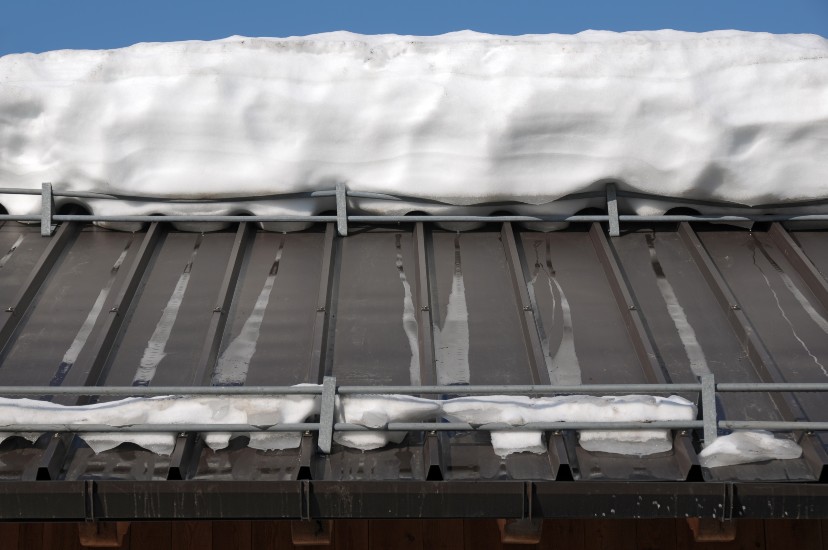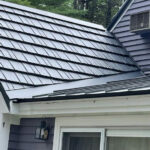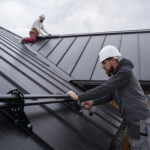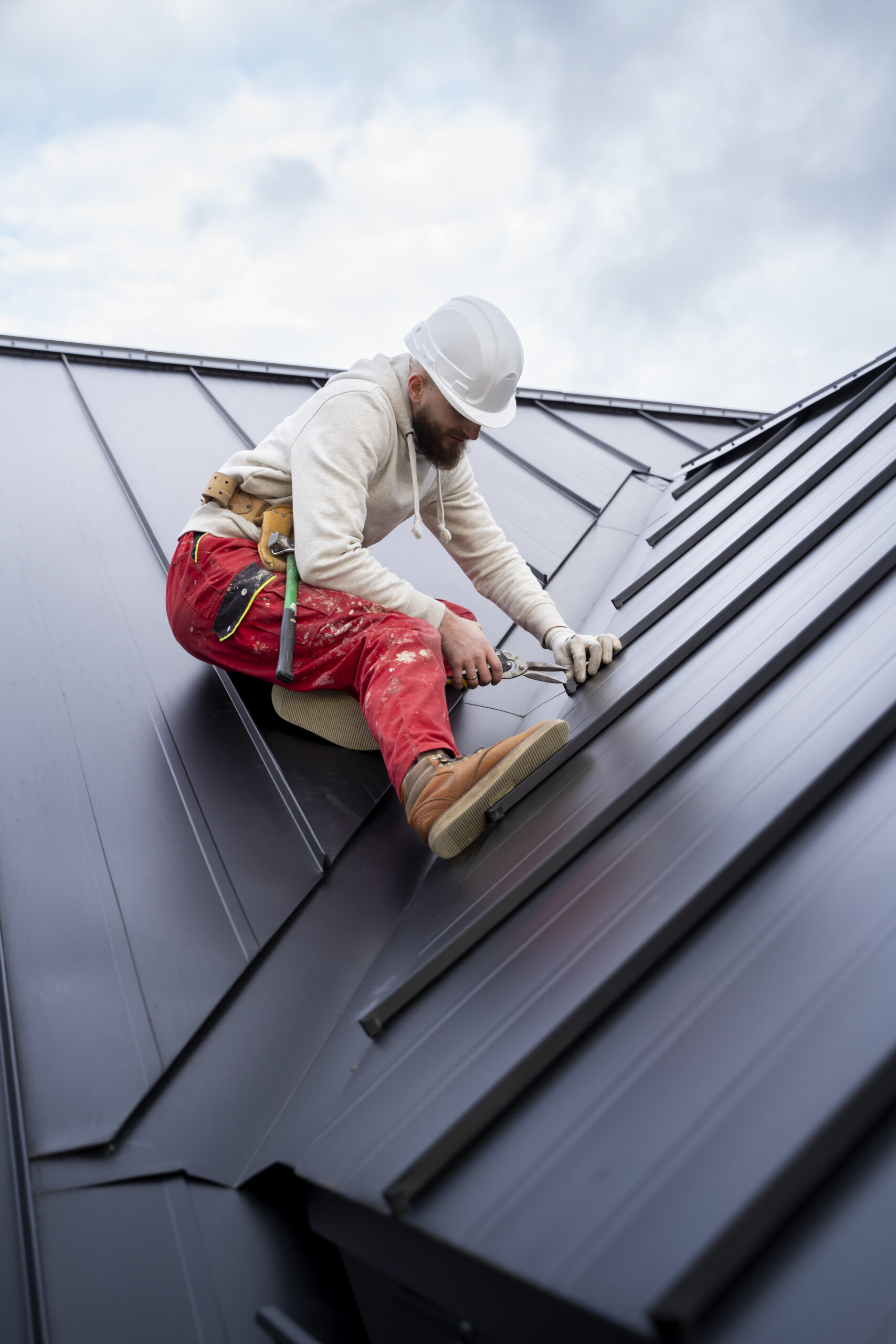Understanding What Is an Ice Dam & Its Impact in New England
January 5, 2024 | By Mike Gonet | Filed under: Blog

Deal With Ice Dams on Your Roof With Classic Metal Roofs
As winter blankets our homes with a glistening layer of snow, the picturesque scenes can often mask potential threats to our roofs. One of the hidden dangers that homeowners may face during colder months is the formation of ice dams. Roofs play a pivotal role in shielding our homes from the unpredictable and sometimes harsh elements of weather. Understanding what ice dams are, how they form, and the risks they pose is crucial for safeguarding your roof and preserving the integrity of your home.
What is an Ice Dam, and How Does It Form?
Essentially, an ice dam is an accumulation of ice on your roof’s edge. When melting snow can’t drain properly because of this ice barrier, it collects and seeps under the shingles, potentially causing significant damage to your roof, ceilings, walls, and insulation. The primary culprit behind the formation of an ice dam is heat loss from your house, typically through the attic. When your roof’s upper part, which is generally over the main part of your house, warms, it melts the bottom layer of the snow accumulated on the roof. However, the colder, lower part of your roof (i.e., over your eaves) does not experience this warming, so the meltwater re-freezes into a ridge of ice, thus creating an ice dam.
Are Ice Dams Dangerous?
Yes, ice dams can be dangerous for a few reasons. While they might look harmless or even beautiful hanging from the edge of a roof, ice dams can cause extensive problems if not promptly addressed. It is important to understand the various threats they pose, which can have devastating implications ranging from structural damage to health and safety concerns. While the roof diligently defends against various weather conditions, the formation of ice dams poses a unique challenge. The process of warm air rising, melting snow, and subsequent refreezing can compromise this first line of defense, leading to potential issues such as:
- Roof Damage – Ice dams can cause serious damage to your home. They can tear off gutters and loosen shingles. As water seeps under the shingles, it can cause them to lift and even detach, damaging the integrity of your roof.
- Structural Deterioration – When shingles get loose, it can cause water to back up and pour into your house. This can lead to peeling paint, warped floors, stained and sagging ceilings, and damaged plaster.
- Icicle Hazards – The icicles that often form along the eaves due to ice dams can become hazardous. Large, heavy icicles may detach and fall, posing a risk to people and property below.
- Mold and Mildew – The moisture that seeps into a house due to ice dams can lead to mold growth. Moisture penetration through your walls and ceilings is a breeding ground for mold and mildew, impacting indoor air quality. This can pose a risk to the health of people living in the house, especially those with allergies or respiratory conditions like asthma.
How Do I Know If I Have an Ice Dam?
As winter rolls around, ice dams can form on your rooftop. Not only do they weigh heavily on your roof, but they can also cause water to seep inside, resulting in unsightly stains and costly repairs. These formations may be challenging to detect, but paying attention to the following signs can alert you to their presence, helping you address the problem before it escalates. Here are six indicators that might suggest you have an ice dam:
- Large icicles hanging from your eaves or gutters
- Ice buildup at the edge of the roof
- No water draining from downspouts
- Unusual cold spots on the roof where snow isn’t melting
- Water stains or moisture in your attic or along the ceiling
- Peeling paint or damp, swollen insulation
How Do I Prevent Ice Damming on My Roof?
Taking preventative measures against ice dam formation is more beneficial and cost-effective in the long run than dealing with water damage and roof repairs. Although ice dams may seem harmless and even beautiful, with their icicles hanging down from the roofs, they can cause serious issues. By implementing these tips to prevent ice dams, you can safely navigate through the winter without any unwanted icy interruptions:
- Improve Insulation – Boosting your attic’s insulation can deter ice dam buildup. This is due to warm air from your home not reaching and melting snow on the roof, lessening the chances of ice dam formation.
- Get a Metal Roof – A metal roof can help eliminate ice dam issues, as snow and ice slide off easier than traditional shingle roofs. Besides this, they are durable, long-lasting, and energy-efficient.
- Maintain Gutter Cleanliness – A blocked gutter system can facilitate ice dam formation. Make sure your gutters are free from debris to ensure that melted snow can flow away.
- Install Snow Guards – Adding snow guards to your roof is another effective method to prevent ice damming. Snow guards hold the snow in place, allowing it to melt slowly and evenly, which reduces the risk of water pooling and freezing to form ice dams. They are especially beneficial for metal roofs where the snow tends to slide off quickly
- Install Roof and Gutter Heating Cables – Heating cables can help prevent ice dams. When fitted along roof edges and inside gutters, they efficiently emit enough heat to deter ice buildup.
- Regularly Rake Your Roof – Use a roof rake to remove snow from your roof safely. Doing this after every snowfall can reduce the likelihood of ice dams forming.
- Ensure the Attic is Cool and Ventilated – Keeping your attic cool can prevent ice dams. Proper insulation and ventilation can minimize the heat transfer that triggers ice damming.
What Happens If I Have an Ice Dam on My Roof?
If you do get an ice dam, there are ways to remove them. But never attempt to remove them by hacking or chipping away because this can cause damage to your roof. Instead, using a roof rake, carefully pull the snow down the slope of the roofline. Do not pull snow across the roof, as it could break the shingles. For persistent or larger ice dams, we recommend enlisting professional help.
At Classic Roofs, our recommended method to remove ice dams is with steam. It’s a quick and efficient way of removing ice dams. The high temperature of the steam melts the ice dam without causing damage to your shingles. Ready to eliminate those pesky ice dams? Contact our team for safe and efficient ice dam removal services.
Preventing Ice Dams for Good
Make ice dams a thing of the past. Here at Classic Metal Roofs, we specialize in metal roofing solutions specifically designed to combat and eliminate common issues such as ice dams. Not only do our roofing systems significantly reduce the risk of these winter hazards, but they are also sustainable, energy-efficient, and durable, assuring protection that lasts a lifetime.
With winter on its way, don’t wait for the first snowfall to secure your home’s protection. Take action now and reap the benefits all year long. If you’re ready to make ice dams history and want to upgrade to a durable and energy-efficient metal roofing solution, contact us today to schedule your free consultation.





